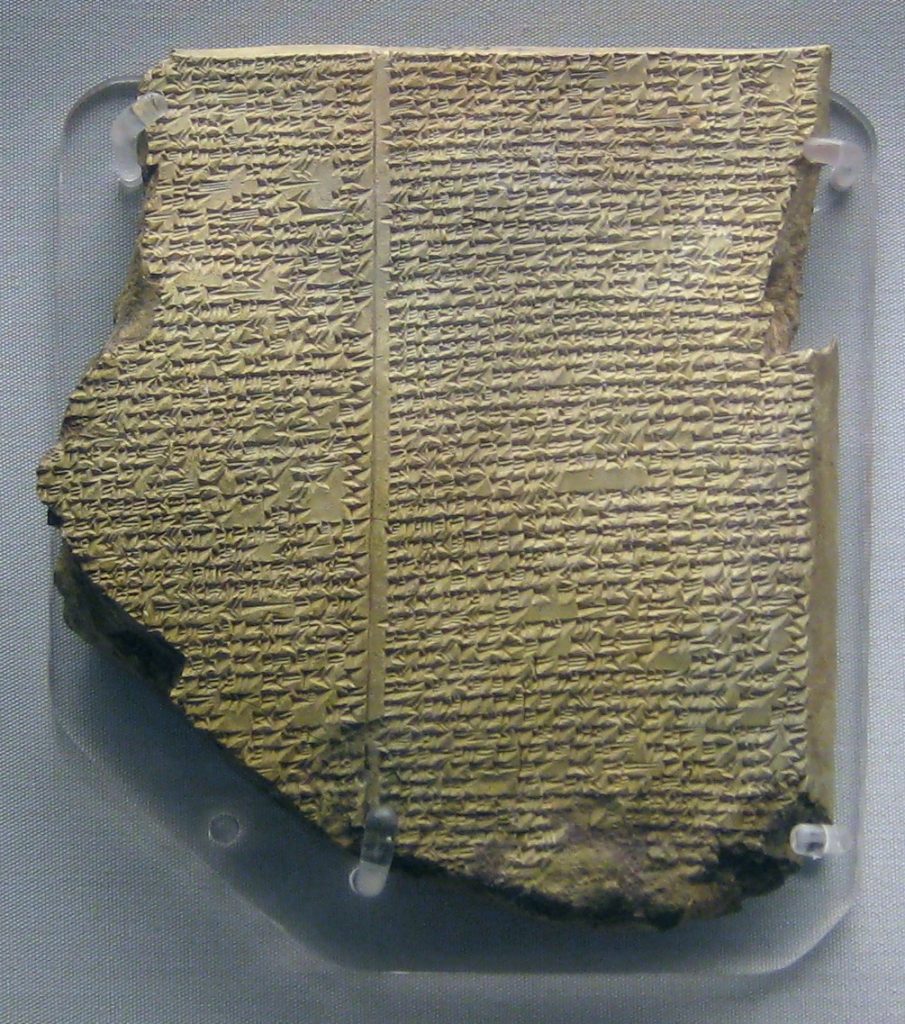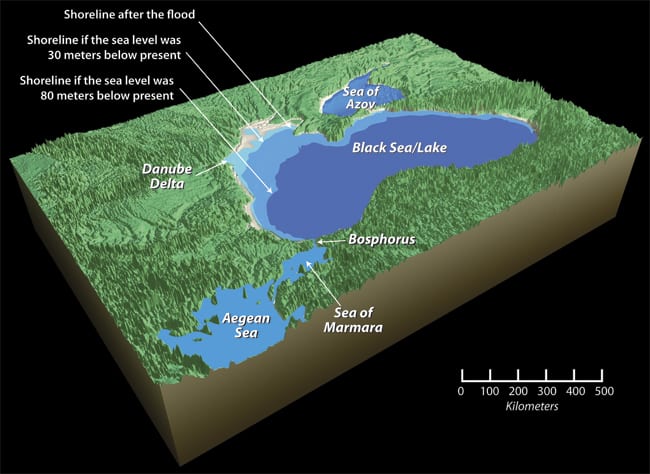
Some scholars believe that the earliest versions of the Epic of Gilgamesh may have been written as early as c. 2500–2400 BCE in Sumerian. These early stories, often called the “Gilgamesh poems,” were independent tales about Gilgamesh, rather than a unified epic. Over time, these stories were compiled and expanded, eventually forming the Old Babylonian version around c. 1800 BCE, and later the Standard Babylonian version around c. 1200 BCE.

Many scholars believe Genesis was compiled later, around 1000 BCE or later,
1. Linguistic Evidence
- The Hebrew used in Genesis appears to be later than the time of Moses and shows characteristics of Hebrew from the monarchic period (1000–500 BCE).
- Some phrases and structures resemble later biblical Hebrew, rather than the older forms found in inscriptions from Moses’ supposed time.
2. Documentary Hypothesis (Multiple Sources)
- The Documentary Hypothesis suggests that Genesis was compiled from multiple sources (J, E, P, D) over time.
- The Yahwist (J) source, which often uses YHWH (Yahweh) as God’s name, is thought to have originated in the 10th century BCE (during King David or Solomon’s reign).
- The Elohist (E) source, which uses Elohim for God, is often linked to the 9th century BCE (Northern Kingdom of Israel).
3. Anachronisms and Cultural References
- Some references in Genesis seem to reflect a later period, such as:
- Mentions of the Philistines (Genesis 21:32, 26:1), who didn’t arrive in Canaan until around 1200 BCE.
- Political and social structures that fit better with the monarchic period (1000 BCE and later).
4. Influence of Mesopotamian and Canaanite Myths
- Genesis shares themes with Mesopotamian myths, such as the Epic of Gilgamesh (flood story) and the Enuma Elish (creation story).
- Some scholars argue that these stories were adapted and written down in their biblical form during the Babylonian Exile (6th century BCE).
5. Absence of Early Copies
- The oldest copies of Genesis (from the Dead Sea Scrolls, 3rd–1st century BCE) are much later than Moses’ time.
- No direct evidence of a fully written Genesis before 1000 BCE has been found.
Conclusion
While oral traditions likely existed much earlier, many scholars believe Genesis was compiled and written down around 1000 BCE or later, possibly during the reign of David or Solomon, and finalized in the 6th–5th century BCE. This theory is based on linguistic, literary, and archaeological evidence.
source: https://www.youtube.com/@TabletsAndTemples
The Epic of Gilgamesh contains a flood story strikingly similar to the biblical account of Noah’s Ark in Genesis 6–9. Scholars believe that the Mesopotamian flood myth predates the biblical version, with the Epic of Gilgamesh dating to at least the 18th century BCE in its earliest form, though its oral traditions may be older. The biblical flood narrative is generally dated by scholars to the 6th–5th century BCE during the Babylonian Exile, suggesting that it may have been influenced by older Mesopotamian traditions, such as those found in Gilgamesh and Atra-Hasis (another Mesopotamian flood myth).
Key similarities between the two stories include:
- A divine decision to flood the earth to destroy humanity.
- A chosen man (Utnapishtim in Gilgamesh, Noah in the Bible) warned to build a large boat.
- The inclusion of animals on the vessel.
- The flood lasting several days.
- The release of birds (a dove and a raven) to find dry land.
- The offering of a sacrifice after the flood, which pleases the gods/God.
- The survivor receiving a form of divine blessing or reward.
Despite these similarities, key differences exist:
- The gods in Gilgamesh act out of impulsiveness and regret, whereas the biblical God acts with justice and a covenantal promise.
- Utnapishtim is granted immortality, whereas Noah simply receives a divine blessing.
Summary of the Flood Story in the Epic of Gilgamesh
In Tablet XI of the Epic of Gilgamesh, the hero Gilgamesh seeks the secret of immortality from Utnapishtim, the only human granted eternal life by the gods. Utnapishtim recounts how he survived a great flood, which had been sent by the gods to destroy humanity.
- The Warning – The god Ea (Enki), the deity of wisdom and water, secretly warns Utnapishtim (also called Ziusudra in other Mesopotamian texts) that the gods have decreed a flood to wipe out mankind. Ea tells him to build a massive boat and bring his family, craftsmen, and animals aboard.
- The Ark’s Construction – Utnapishtim follows the god’s instructions and builds a square-shaped vessel with seven decks. He seals it with bitumen (tar) and loads it with food and living beings.
- The Great Flood – The storm begins, and for six days and seven nights, a catastrophic deluge covers the earth. The gods, seeing the destruction, regret their decision—the goddess Ishtar mourns humanity, and the other gods cower in fear.
- The Waters Recede – On the seventh day, the storm ceases, and the waters begin to subside. Utnapishtim’s boat lands on Mount Nimush (sometimes compared to Mount Ararat).
- The Release of Birds – To determine if the land is dry, Utnapishtim releases a dove, which returns, then a swallow, which also returns, and finally a raven, which does not return—indicating that the waters have receded.
- The Sacrifice and Divine Reaction – Utnapishtim offers a sacrificial offering to the gods. The gods, smelling the aroma, gather around the sacrifice. Enlil, the god who initially decreed the flood, is at first enraged that a human survived but is eventually pacified by Ea, who convinces him that wiping out all of humanity was excessive.
- The Gift of Immortality – As a reward for surviving the flood, Enlil grants Utnapishtim and his wife eternal life, sending them to live at the “mouth of the rivers,” a faraway paradise.
Conclusion
The flood story in the Epic of Gilgamesh serves as an early precursor to later flood myths, particularly the biblical Genesis narrative. While the broad themes of divine wrath, survival, and renewal are common to both, the Mesopotamian version portrays the gods as more fallible and emotional, whereas the biblical account emphasizes divine justice and covenantal relationships.
Alternate Hypothesis: The Black Sea Flood as Inspiration for the Epic of Gilgamesh and the Biblical Flood

Black Sea deluge theory discussed
Suggested Evidence for the Black Sea Flood Hypothesis
- Geological Evidence of a Sudden Flood
- Rising sea levels at the end of the last Ice Age could have caused the Mediterranean to overflow into the Black Sea, rapidly flooding the region.
- Sediment cores from the Black Sea reveal a dramatic transition from freshwater to saltwater deposits, indicating a sudden and significant rise in water levels, which would have occurred relatively quickly.
- Displacement of Early Settlements
- Evidence of Neolithic settlements along the Black Sea coast suggests that these communities were suddenly abandoned, possibly due to a rapid flooding event. Artifacts, including pottery, tools, and dwellings, have been found submerged, pointing to the idea that a large-scale natural disaster displaced these early societies.
- Radiocarbon Dating of Organic Material
- Freshwater mollusks and other organic materials found buried beneath marine sediments have been radiocarbon dated to a period of sudden environmental change, supporting the idea of a rapid, catastrophic flood.
- Connection to Flood Myths
- Both the Epic of Gilgamesh and the Noah’s Flood story in Genesis describe a catastrophic, world-altering flood, with central figures (Utnapishtim in Gilgamesh, Noah in Genesis) who survive by building a boat and later land on a mountain after the waters recede.
- It is plausible that such a dramatic event could have been remembered and mythologized in oral traditions over time, with elements of the flood story being passed down and influencing later written accounts. While the flood may not have been global, it could have been a regional catastrophe that was embedded in these cultural myths.
Conclusion
The Black Sea flood, occurring at the end of the last Ice Age, is a potential source of inspiration for the flood narratives found in both the Epic of Gilgamesh and the Biblical story of Noah. The evidence from geology and archaeology suggests that a massive, rapid flood in the region could have contributed to the creation of these enduring myths, even if the exact timing of the event remains uncertain.
